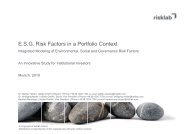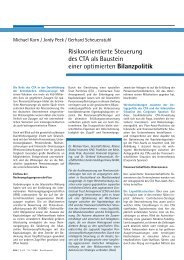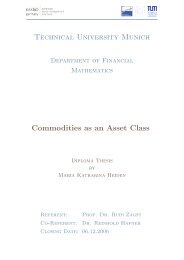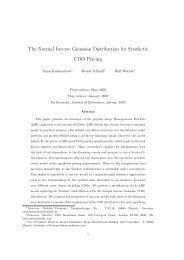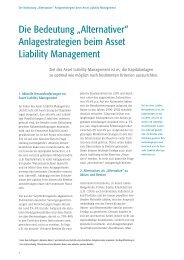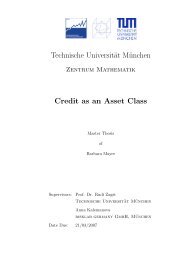Empirical Evaluation of Hybrid Defaultable Bond Pricing ... - risklab
Empirical Evaluation of Hybrid Defaultable Bond Pricing ... - risklab
Empirical Evaluation of Hybrid Defaultable Bond Pricing ... - risklab
Create successful ePaper yourself
Turn your PDF publications into a flip-book with our unique Google optimized e-Paper software.
Þrst introduced by Cathcart & El-Jahel (1998) in form <strong>of</strong> a so called signaling<br />
process. In their model default is explicitly driven by the signaling process<br />
which is assumed to follow a geometric Brownian motion. The second underlying<br />
process is the non-defaultable short rate which is assumed to follow a mean<br />
reverting square root process. The model <strong>of</strong> Schmid & Zagst (2000) differs<br />
from Cathcart and El-Jahel in several ways: First, they assume the underlying<br />
non-defaultable short rate to follow either a mean reverting Hull-White process<br />
or a mean-reverting square root process with time-dependent mean reversion<br />
level. The uncertainty or signaling process is assumed to follow a mean reverting<br />
square root process. Finally, in addition to the non-defaultable short rate<br />
and the uncertainty index, they directly model the short rate spread process:<br />
they assume that the spread between a defaultable and a non-defaultable bond<br />
is considerably driven by the uncertainty index but that there may be additional<br />
factors which inßuence the level <strong>of</strong> the spreads: at least the contractual<br />
provisions, liquidity and the premium demanded in the market for similar instruments<br />
have a great impact on credit spreads. The model <strong>of</strong> Schmid & Zagst<br />
(2000) was empirically tested by Schmid & Kalemanova (2002) for German and<br />
Italian sovereign bond data over a period <strong>of</strong> two years.<br />
Based on these encouraging results for time histories up to two years we<br />
want to further improve the model to make it more stable even for long term<br />
horizons <strong>of</strong> ten years and more. Therefore, we extend the original three-factor<br />
approach to a model where we directly consider the general state <strong>of</strong> the economy<br />
in terms <strong>of</strong> GDP growth rates. We assume that the general state <strong>of</strong> the economy<br />
is an important factor for explaining interest rate and spread levels and<br />
modeling systematic risks. In addition, we keep the uncertainty index to model<br />
the Þrm-speciÞc default risk. We show that the additional factor in our model<br />
has a signiÞcant impact on the quality <strong>of</strong> the model. By empirically comparing<br />
the new model with other hybrid models we close a gap in the literature: So far<br />
there are no empirical analyses systematically evaluating and comparing different<br />
hybrid models. In different models the conditional probability <strong>of</strong> default and<br />
the credit spread are directly related to speciÞc macro- and/or microeconomic<br />
factors. We consider three speciÞc representatives: The model <strong>of</strong> Schmid &<br />
Zagst (2000) as an example for the group <strong>of</strong> models where the spread is dependent<br />
on a Þrm-speciÞc factor. The model <strong>of</strong> Bakshi et al. (2001a) which belongs<br />
to the group <strong>of</strong> models where the spread depends on non-defaultable interest<br />
rates and a Þrm-speciÞc factorandÞnally the extended model <strong>of</strong> Schmid and<br />
Zagst who make the spread dependent on the general state <strong>of</strong> the economy and<br />
a Þrm-speciÞc factor.<br />
The rest <strong>of</strong> the paper is organized as follows. In Section 2 we present the<br />
general market model and the data we use to test the different hybrid defaultable<br />
bond pricing models. In Sections 3, 4 and 5 we give an overview <strong>of</strong> the<br />
model <strong>of</strong> Schmid & Zagst (2000), the extended model <strong>of</strong> Schmid and Zagst and<br />
the approach <strong>of</strong> Bakshi et al. (2001a), respectively. For each model, we show<br />
the closed form pricing formulas for defaultable and non-defaultable bonds and<br />
4



